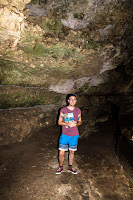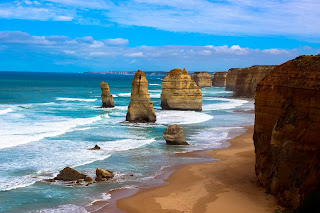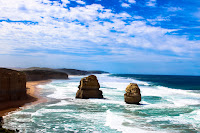19.01.2013
It had been an uncomfortable nights sleep in Priscilla - our camper van - after temps peaked at 40oC (104oF!) yesterday, but it was a cooler start to day 12 of the trip and we were ready to drive the 15 km across the border to South Australia. On route, we passed numerous Quarantine signs warning us not to bring fruit, vegetables, plants or grapevines across the border. Quarantines are enforced in most states to prevent fruit fly or phylloxera (related to an aphid) infestations which can ruin crops, and so bins are provided along the free ways for disposal of fruit and veg.
It wasn't long until we arrived in Mount Gambier, which manages to hold the title of second biggest city in S.A with a modest population of just 24,000 people! This is possible because over 70% of people in the entire state live in it's capital of Adelaide, where we would visiting in a few days time.
Stop #1 today was the giant Umpherston Sinkhole which over time has been transformed into a beautiful "sunken garden". It is the less popular tourist attraction here, but a great place to explore. You can climb down the steps into what is basically a large hole in the ground and take in the wildlife or the small caves along the edges. Originally the whole site was a large cave much like the ones found all over this part of Oz, but the top of the chamber collapsed - or sunk - downwards creating the hole. The topsoil is very rich and provides lots of nutrients to feed the huge array of plant life here. The spot is also very popular with the local possums, particularly at dusk when there is a dedicated possum tour here most evenings.
We then headed into the CBD to pick up a different type of transport to make our way to stop #2. A number of cycles found at the town library are hired out completely free of charge - we left a swipe of our credit card as bond and we were on our way to the most famed landmark in Mount Gambier. Unfortunately the route was slightly uphill and neither of us are particularly fit, so the novelty of the bikes soon wore off!
All that effort was worth it when we got there though. The Blue Lake is a large lake located next to the extinct volcanoes which dominate this region. It was originally one of four crater lakes in the town but two have dried up over the last 40 years due to dropping water levels, and so now only two remain - and it is this one that provides the most interest! It is a big lake with an average depth of around 72 meters (75m at it's deepest) and it measures 1087m (3566 feet) by 657m (2155 feet). What makes it special is that whilst most of the year it is an ordinary grey colour, during December to March the water turns to a vibrant blue. The exact cause is still argued by scientists but it is thought that the warming of the water to 20oC+ during summer months causes micro-crystallites of calcium carbonate to form, causing a scatter of blue wavelengths of sunlight and creating this rich but beautiful shade of colour.
The photos don't show just what a magnificent shade of blue the lake is in real life. It is stunning to witness in person and you can take in the view from various look-outs dotted around the large crater. There are other lakes (although some are dried up) and other pretty views to be found in the surrounding parkland. The mystery behind the magical colour - which is still contested to this day - only adds to the allure of the place, making it well worth a visit.
After taking in the beautiful sights, we returned our bikes to the library just in time to watch the free documentary shown here about the volcanic history of the whole area and the 8 volcanic eruptions which led to Mount Gambier's existence. It is a surprisingly high calibre docufilm, which lasts an hour and is packed with interesting information, great visuals and fascinating commentary. Whilst here it is also worth checking out the second, smaller sink hole located next door to the library - it may not be as big but it is equally as impressive. We finished the day at our camp site at Mount Gambier Showground which was the most basic (and at $20, the cheapest) one we stayed in throughout the whole trip. Still, we had power, some old-fashioned bathroom & shower facilities and a few friendly neighbours.
I will end this post with a couple of photo's from earlier in the day. These are examples of the many anti-speeding road signs found all over Oz but we particularly enjoyed the ones found in this part of the country. Whilst they send out a serious message, the use of humour certainly brought a smile to our faces - and of course, we always strictly kept to the speed limit at all times on our trip.
Check out my next post when we take a trip down a couple of caves in Naracoorte, S.A - an awesome and unforgettable experience!












































































